be prepared for an emergency
Supplies and Procedures to Note
No one wants to think about what would happen if a disaster were to hit us at home or at the cottage, but being prepared is everything. Over the years, there have been storms in the area that have cut off power for days, washed out roads and bought down trees, preventing people from leaving their cottages.
To help your family weather a disaster, take time now to prepare: make an evacuation plan and assemble a disaster kit for an extended stay at the cottage without power. |
|
“Be Prepared”
Following are some suggestions for things to keep on hand in case you get stranded. Remember, once the emergency strikes it’s too late to stock up!
Basics
Water
- 1 gallon per person per day. Have enough for at least a three-day supply, if not longer.
Consider that children, nursing mothers, and people who are ill might need more water. Medical emergencies can also necessitate a larger water supply. The weather can also play a part in how much water you need. - Water purification (battery powered UV, Hand Pumps with ceramic filter or purification tablets found in camping stores)
Food/Medicine
- Minimum 3-day supply of non-perishable food (don’t forget the handheld can opener).
Include any special dietary items. - Any prescription medications (the Red Cross recommends a 7-day supply)
- First-aid kit
- Pet supplies (if needed)
- Baby supplies (if needed)
- Keep your medicine cabinet stocked: cottage medicine cabinet checklist
Hygiene
- Hand sanitizer/wipes/garbage bags/ties
- Feminine products
COMFORT/WARMTH
- Sleeping bags, BLANKETS
- Change of clothing for everyone (long-sleeved shirt, long pants, good shoes/boots)
- Towels
Household & Outdoor Items
- Fire extinguisher(s)
- Matches in a waterproof container.
- Paper and pen/pencil.
- Ziplock storage bags
- Cord /rubber bands / waterproof adhesive tape.
- Scissors/Swiss Army Knife/Multitool
- Work gloves
- Basic toolkit with wrenches, screwdrivers, cutters, pliers and a knife.
- Chainsaw, Handsaw, Axe
- High visibility clothing
- Whistle /air horn to make it easier for rescue crews to locate you/flares.
- Dust masks, plastic tarps, and duct tape to shelter if you need to.
- Maps of the area (remember that your phone might not work)
- Compass
Extra supplies
- Cash
- Copies of your family’s important documents (make sure to store these in a waterproof container of some sort)
- Printed copy of Contact information for neighbours and emergency services
- Books and games for children
For Power Outages
- Cooking and heating water
- When buying your next gas BBQ consider one with a side burner
- Camping stove and extra propane/fuel
- Firewood for woodburning fireplace
- Power
- Extra batteries
- Battery-powered or crank radio with Weatheradio Canada capability– 162.400-162.550MHz
- Flashlights
- Battery operated lanterns (avoid candles if you can).
- Solar panel system for charging devices, lights and more.
- Solar lights – look for ones that you can turn off to save power and allows them to charge and ready to use rather than those that always come on at dusk.
- Generator (as long as you know how to use it safely) and have extra gas.
- Power pack to recharge and run Cell phones.
- USB power adaptor for your vehicle if it doesn’t have one.
- Invertor to convert your vehicle’s 12VDC power to 120V AC power.
Highlands East offers more information on their Emergency Preparedness page.
Thanks to KLA member Rob Horsburgh for his photograph of Wallace Island used as the background photo throughout this site

